
Organisms of many species are specialized into male and female varieties, each known as a sex. Sexual reproduction involves the combining and mixing of genetic traits: specialized cells known as gametes combine to form offspring that inherit traits from each parent. The gametes produced by an organism define its sex: males produce small gametes while females produce large gametes. Individual organisms which produce both male and female gametes are termed hermaphroditic. Gametes can be identical in form and function, but, in many cases, an asymmetry has evolved such that two different types of gametes (heterogametes) exist.
The Common Object Request Broker Architecture (CORBA) is a standard defined by the Object Management Group (OMG) designed to facilitate the communication of systems that are deployed on diverse platforms. CORBA enables collaboration between systems on different operating systems, programming languages, and computing hardware. CORBA uses an object-oriented model although the systems that use the CORBA do not have to be object-oriented. CORBA is an example of the distributed object paradigm.
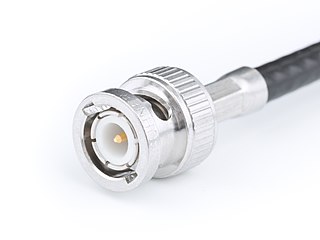
The BNC connector is a miniature quick connect/disconnect radio frequency connector used for coaxial cable. The interface specifications for the BNC and many other connectors are referenced in MIL-STD-348. It features two bayonet lugs on the female connector; mating is fully achieved with a quarter turn of the coupling nut. BNC connectors are used with miniature-to-subminiature coaxial cable in radio, television, and other radio-frequency electronic equipment, test instruments, and video signals. The BNC was commonly used for early computer networks, including ARCnet, the IBM PC Network, and the 10BASE2 variant of Ethernet. BNC connectors are made to match the characteristic impedance of cable at either 50 ohms or 75 ohms. They are usually applied for frequencies below 4 GHz and voltages below 500 volts.

An electrical connector is an electro-mechanical device used to join electrical terminations and create an electrical circuit. Electrical connectors consist of plugs (male-ended) and jacks (female-ended). The connection may be temporary, as for portable equipment, require a tool for assembly and removal, or serve as a permanent electrical joint between two wires or devices. An adapter can be used to effectively bring together dissimilar connectors.
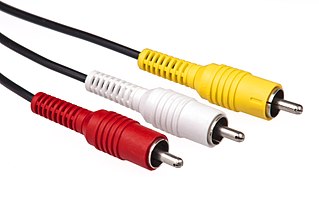
An RCA connector, sometimes called a phono connector or Cinch connector, is a type of electrical connector commonly used to carry audio and video signals. The name RCA derives from the Radio Corporation of America, which introduced the design by the early 1940s for internal connection of the pickup to the chassis in home radio-phonograph consoles. It was originally a low-cost, simple design, intended only for mating and disconnection when servicing the console. Refinement came with later designs, although they remained compatible.
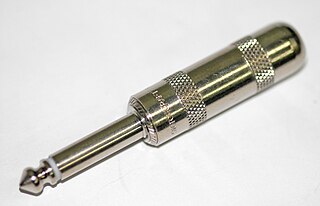
A phone connector, also known as phone jack, audio jack, headphone jack or jack plug, is a family of electrical connectors typically used for analog audio signals.
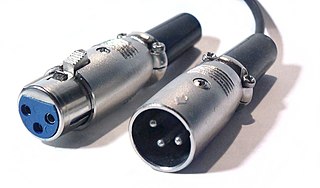
The XLR connector is a style of electrical connector, primarily found on professional audio, video, and stage lighting equipment. The connectors are circular in design and have between three and seven pins. They are most commonly associated with balanced audio interconnection, including AES3 digital audio, but are also used for lighting control, low-voltage power supplies, and other applications. XLR connectors are available from a number of manufacturers and are covered by an international standard for dimensions, IEC 61076-2-103. They are superficially similar to the smaller DIN connector range, but are not physically compatible with them.
A DC connector is an electrical connector for supplying direct current (DC) power.

A DIN connector is an electrical connector that was originally standardized in the early 1970s by the Deutsches Institut für Normung (DIN), the German national standards organization. There are DIN standards for a large number of different connectors, therefore the term "DIN connector" alone does not unambiguously identify any particular type of connector unless the document number of the relevant DIN standard is added. Some DIN connector standards are:
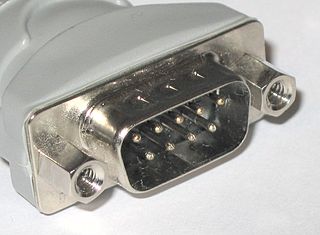
The D-subminiature or D-sub is a common type of electrical connector. They are named for their characteristic D-shaped metal shield. When they were introduced, D-subs were among the smallest connectors used on computer systems.

The F connector is a coaxial RF connector commonly used for "over the air" terrestrial television, cable television and universally for satellite television and cable modems, usually with RG-6/U cable or, in older installations, with RG-59/U cable.

SMA connectors are semi-precision coaxial RF connectors developed in the 1960s as a minimal connector interface for coaxial cable with a screw-type coupling mechanism. The connector has a 50 Ω impedance. SMA is designed for use from DC to 18 GHz, and is most commonly used in microwave systems, hand-held radio and mobile telephone antennas, and more recently with WiFi antenna systems and USB software-defined radio dongles. It is also commonly used in radio astronomy, particularly at higher frequencies.

A banana connector is a single-wire electrical connector used for joining wires to equipment. The term 4 mm connector is also used, especially in Europe, although not all banana connectors will mate with 4 mm parts, and 2 mm banana connectors exist. Various styles of banana plug contacts exist, all based on the concept of spring metal applying outward force into the unsprung cylindrical jack to produce a snug fit with good electrical conductivity. Common types include: a solid pin split lengthwise and splayed slightly, a tip of four leaf springs, a cylinder with a single leaf spring on one side, a bundle of stiff wire, a central pin surrounded by a multiply-slit cylinder with a central bulge, or simple sheet spring metal rolled into a nearly complete cylinder. The plugs are frequently used to terminate patch cords for electronic test equipment, while sheathed banana plugs are common on multimeter probe leads.

In electrical and mechanical trades and manufacturing, each half of a pair of mating connectors or fasteners is conventionally assigned the designation male or female. The "female" connector is generally a receptacle that receives and holds the "male" connector. On occasion, the terms "male" and "female" are respectively referred to as the A and B ends, though the names of some standards conflict with this as they contain the letters A or B within the name; unambiguous, though rare, terms include plug and socket or jack.
An interference fit, also known as a press fit or friction fit is a fastening between two parts which is achieved by friction after the parts are pushed together, rather than by any other means of fastening.

Molex connector is the vernacular term for a two-piece pin and socket interconnection. Pioneered by Molex Connector Company, the two-piece design became an early electronic standard. Molex developed and patented the first examples of this connector style in the late 1950s and early 1960s. First used in home appliances, other industries soon began designing it into their products from automobiles to vending machines to mini-computers.

Anablepidae is a family of fishes which live in brackish and freshwater habitats from southern Mexico to southern South America. There are three genera with sixteen species: the four-eyed fishes, the onesided livebearers and the white-eye, Oxyzygonectes dovii. Fish of this family eat mostly insects and other invertebrates.
The Luer taper is a standardized system of small-scale fluid fittings used for making leak-free connections between a male-taper fitting and its mating female part on medical and laboratory instruments, including hypodermic syringe tips and needles or stopcocks and needles. Currently ISO 80369 governs the Luer standards and testing methods.
Nicrophorus defodiens is a burying beetle described by Mannerheim in 1846.

The anglerfish is a fish of the teleost order Lophiiformes. It is a bony fish named for its characteristic mode of predation, in which a fleshy growth from the fish's head acts as a lure.

















